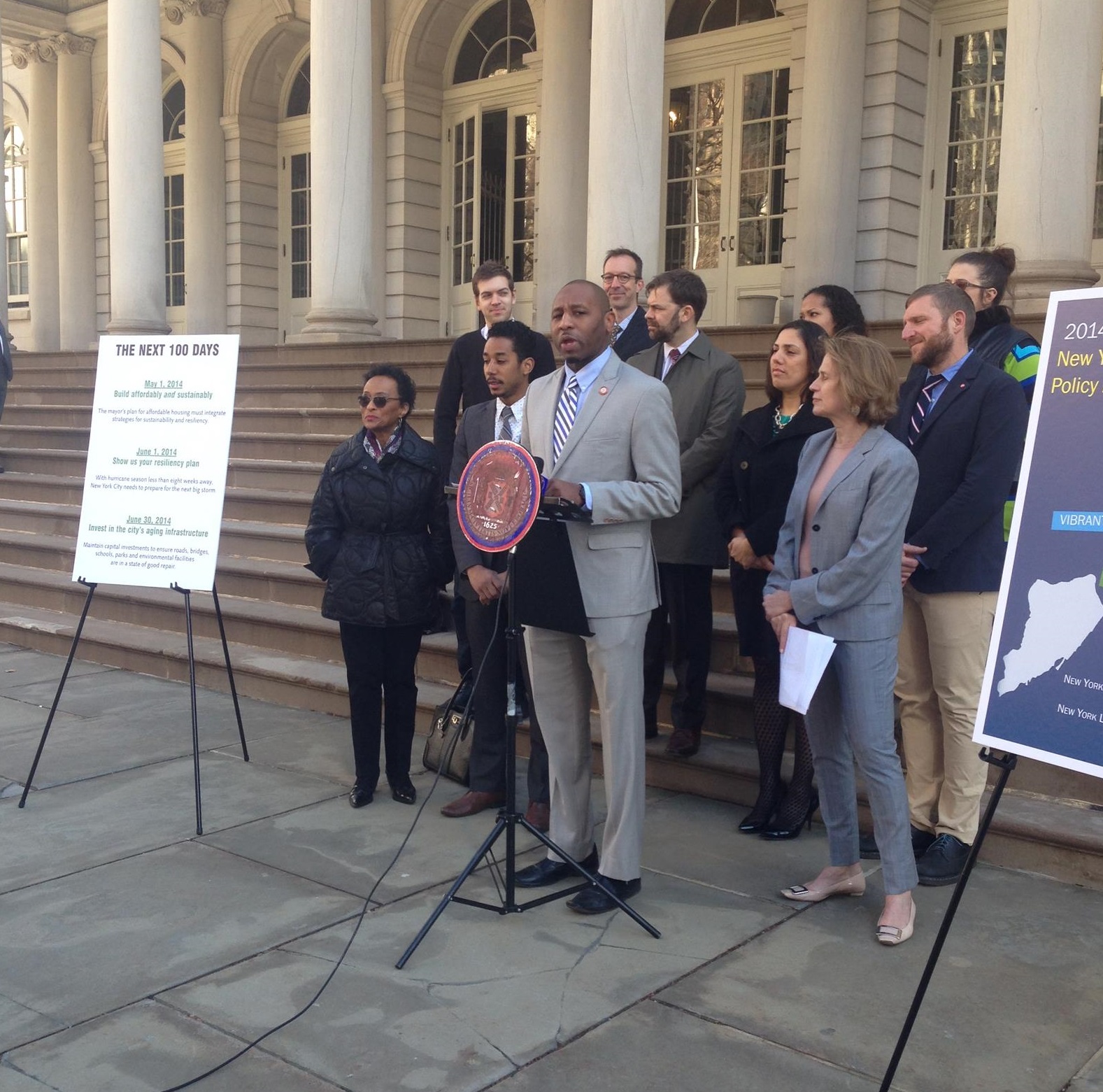by: EmmaPattiz
On Thursday, 04.10.14, the New York League of Conservation Voters (NYLCV) held a demonstration on the steps of City Hall calling on Mayor Bill de Blasio, on his 100th day in office, to focus on sustainability and resiliency efforts in his next 100 days. The press conference announced three suggested steps that, if implemented, will better prepare New York City for future climate change and weather-related events. NYLCV President Marcia Bystryn gave the opening remarks and outlined the three milestones that emphasize long-term planning in a post-Sandy New York City:
- The de Blasio Administration has set 05.01.14 as the deadline to announce its plan to add and preserve 200,000 affordable housing units. These units should be built sustainably and resiliently. They should also include access to transit and parks.
- The official start of the next hurricane season is 06.01.14. The mayor should initiate a comprehensive plan to ensure that New York is prepared for the next storm and the changing climate.
- The deadline for a finalized city budget is 06.30.14. Sustainability and resiliency planning must be included in the capital plan, in addition to vital infrastructure repairs.
This three-point plan, developed and promoted by experts representing a wide range of professions and interest groups as well as city officials, will steer the de Blasio Administration in the right direction. Speakers stressed that these issues affect the lives of all New Yorkers.
Council Member Donovan Richards, chair of the Environmental Protection Committee, District 31, supports the plan. Richards’ district, which includes the Rockaways, suffered greatly from Superstorm Sandy. He said it is essential that the mayor’s office prioritizes vulnerable populations – the elderly and children. Richards believes that the prior administration taught us a lesson in unpreparedness, but the city has an opportunity to get it right. In order to have a “greener” New York City, new development must include parks, dunes, geothermal energy, and transportation alternatives. New York City is not prepared for the next hurricane. Communities under water need to see tangible investments in infrastructure, which will mean drastically increasing capital investment.
Council Member Antonio Reynoso, chair of the Committee on Sanitation and Solid Waste Management, District 34, said that the city must prepare for the next 100 years, not just the next 100 days. There are voices in City Council and the mayor’s office that agree. Reynoso’s committee has already talked to the newly-appointed NYC Department of Design + Construction Commissioner Dr. Feniosky Peña-Mora about sustainability and resiliency. Reynoso sees a need in his district, which includes Williamsburg, Brooklyn, where there has been a significant increase in residential units in recent years, but additional infrastructure to maintain the community long-term, such as parks and schools, has not kept up.
Andrew S. Hollweck, vice president, Policy and Programs, New York Building Congress (NYBC), said that even before Sandy hit in October 2012, the NYBC had identified the need for greater investment in New York City infrastructure. NYBC understands the importance of investing in parks and schools as well. Hollweck agrees that the mayor must roll out a capital plan that addresses all of these issues.
Veronica Vanterpool, executive director of the Tri-State Transportation Campaign, explained that transportation is the second-largest emitter of greenhouse gases in the United States, and one way to combat this in New York City is through more bus rapid transit service, which can reduce emissions by up to 40%. The administration should focus on holistic transportation-focused development, including complete streets that are safe and encourage sustainable transportation.
Peggy Shepard, executive director of WE ACT for Environmental Justice, briefly mentioned that we are currently facing various challenges, but our most important priority should be making our communities safe, healthy, and sustainable.
Paul Steely White, executive director of Transportation Alternatives, said that the “green” agenda is synonymous with the “peoples’” agenda. The sustainability agenda is the same as the affordability and equity agenda that the mayor references. We have a legacy of outdated streets that are high-emission and unsafe. The city must implement affordable and sustainable transportation systems.
Other points addressed at the gathering included the intended linkage between the NYLCV plan and PlaNYC, implemented by the Bloomberg Administration. Bystryn emphasized that PlaNYC was a good blueprint but needs to be updated. The mayor’s office will have to determine how to integrate PlaNYC with its own agenda.
Read the press release here.
In other news, on Wednesday, 03.26.14, Governor Branstad of Iowa signed Senate File 2255 into law. This legislation will allow architects to aid citizens of Iowa in post-disaster situations, by providing liability protections for registered architects who volunteer their services to assess property damage.
The passing of Senate File 2255 sets a precedent that will hopefully influence policymakers across the country. AIANY continues to advocate for similar legislation in New York State that will allow architects and select related professionals to respond in times of man-made or natural disasters. The need for this legislation was apparent following Sandy, but AIA members have been pushing for these protections for over a decade.
The Good Samaritan bill (S.3942-A, A.4380-B) is currently making its way through the New York State Senate and Assembly. In February, a select group of AIANY and AIANYS representatives visited the offices of Assembly member Deborah Glick to lobby for support of the Good Samaritan bill. We will continue our lobbying efforts on 04.29.14, when AIA representatives from around the state meet with legislators in Albany for AIANYS Architects in Albany Lobby Day.
Read the AIA Iowa press release here.
Emma Pattiz is the Policy Coordinator at the AIA New York Chapter.








